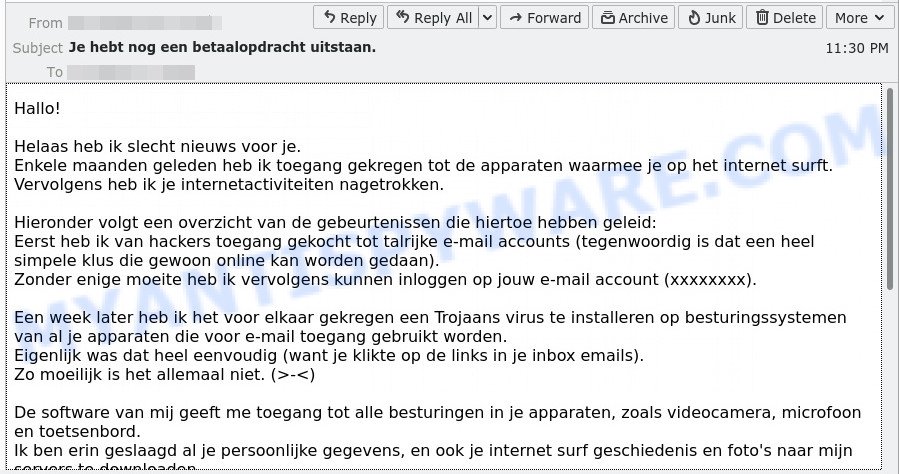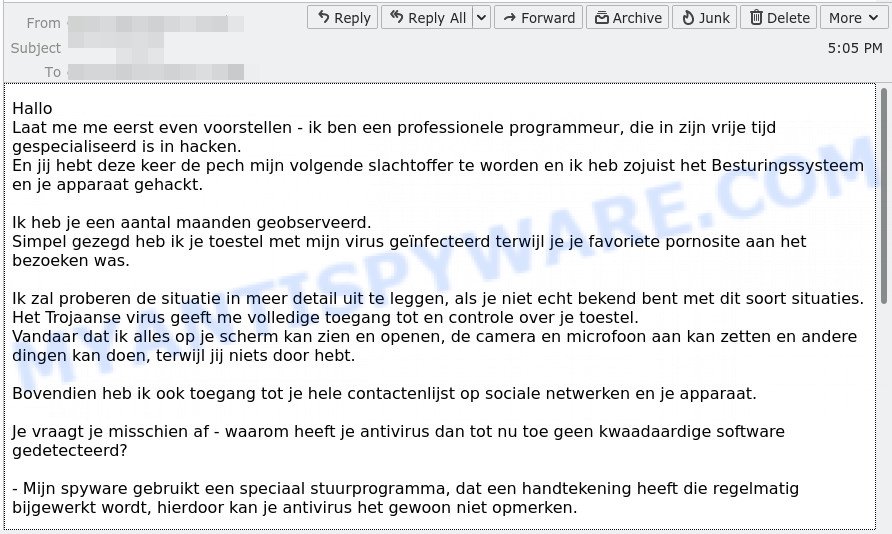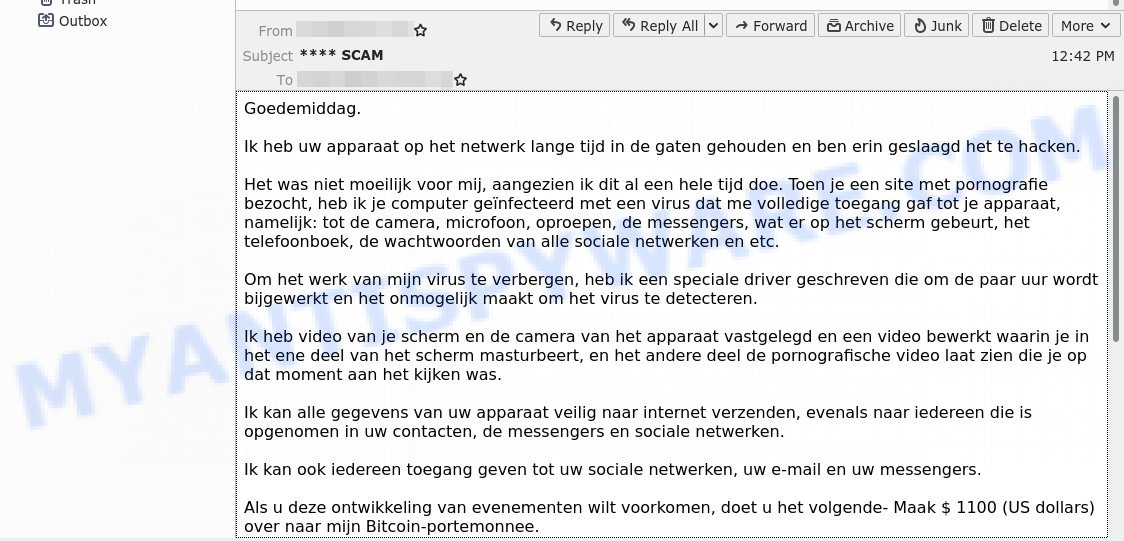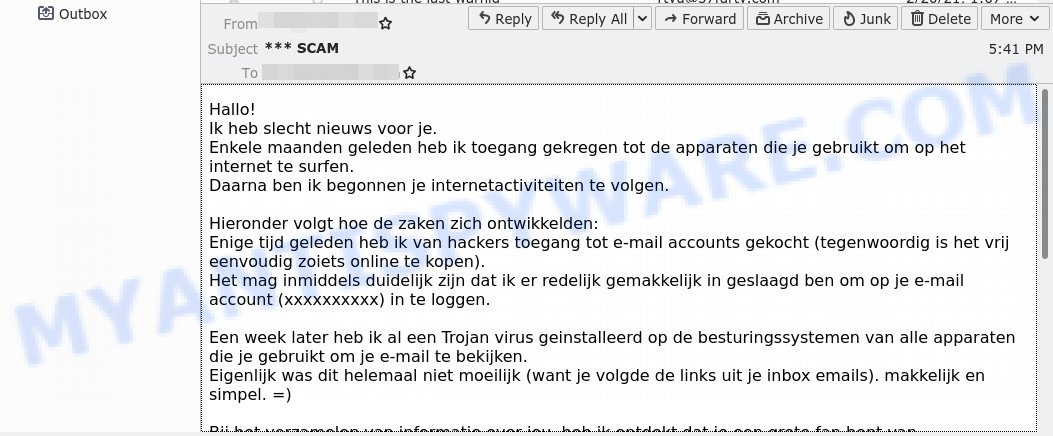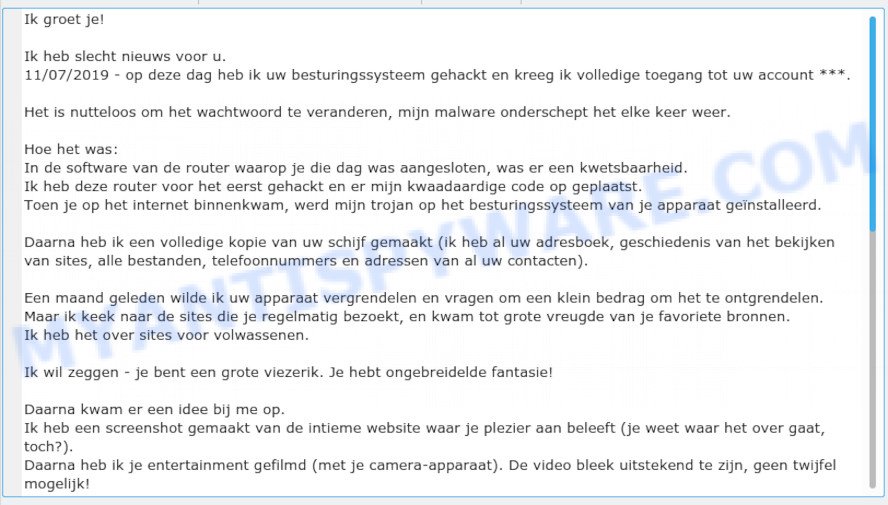What is “Helaas begin ik met slecht nieuws voor je” EMAIL?
Hoi! Helaas begin ik met slecht nieuws voor je. email is a variant of the sextortion scam. Sextortion email scams are targeting email accounts and convincing users they’ve been hacked. Sextortion scams claim that someone has installed malware onto the victim’s computer and they recorded the victim watching porn videos. They threaten to publicize that information if the victim doesn’t pay up — often through a bitcoin payment.
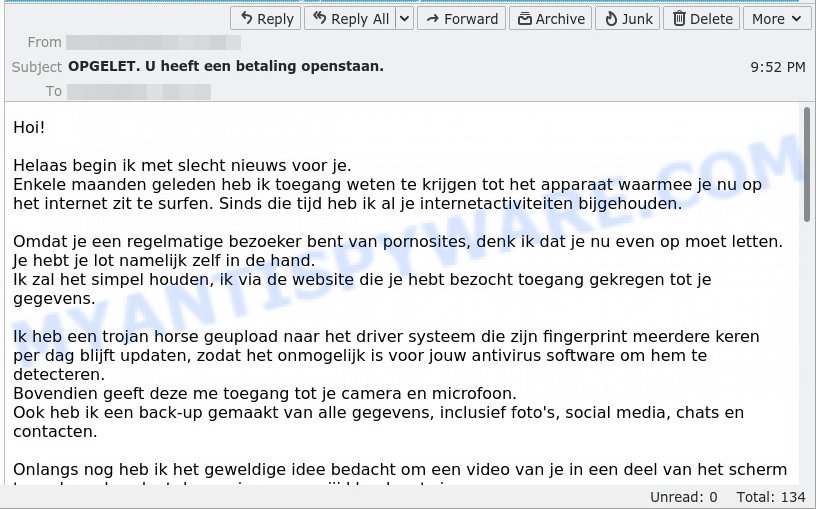
Helaas begin ik met slecht nieuws voor je EMAIL SCAM
QUICK LINKS
- What is “Helaas begin ik met slecht nieuws voor je” SCAM?
- What to do when you receive the scam message?
- How to spot a phishing email?
- Report Scam Email
The Scam in detail
The scam is a new sextortion scam that targets Dutch language users. This scam is a new variant of the Unfortunately, there are some bad news for you Scam.
Scammers use email spam to promote this scam and create many new victims. Scammers slightly changed the original text and translated it into Dutch, preserving the meaning of the text. The size of the ransom has also changed: now the scammers are demanding 950 USD from their victims. In addition, scammers are now using a new bitcoin wallet with the address 1CL8tqcBZKg1QHByZJev9ExBfpUSZcr7Wy.
Text presented in the scam:
Hoi!
Helaas begin ik met slecht nieuws voor je.
Enkele maanden geleden heb ik toegang weten te krijgen tot het apparaat waarmee je nu op het internet zit te surfen. Sinds die tijd heb ik al je internetactiviteiten bijgehouden.Omdat je een regelmatige bezoeker bent van pornosites, denk ik dat je nu even op moet letten. Je hebt je lot namelijk zelf in de hand.
Ik zal het simpel houden, ik via de website die je hebt bezocht toegang gekregen tot je gegevens.Ik heb een trojan horse geupload naar het driver systeem die zijn fingerprint meerdere keren per dag blijft updaten, zodat het onmogelijk is voor jouw antivirus software om hem te detecteren.
Bovendien geeft deze me toegang tot je camera en microfoon.
Ook heb ik een back-up gemaakt van alle gegevens, inclusief foto’s, social media, chats en contacten.Onlangs nog heb ik het geweldige idee bedacht om een video van je in een deel van het scherm te maken, deze laat de manier waarop jij klaarkomt zien,
terwijl de video die je aan het kijken was tegelijkertijd op de andere helft van het scherm wordt afgespeeld. Dat was echt lachen!Ik kan deze video met een paar muisklikken naar je hele contactenlijst toe sturen, ik neem aan dat je dit scenario koste wat kost wilt voorkomen.
Met dat in het achterhoofd is hier mijn voorstel:
Maak het bedrag van 1650 USD in BTC over naar mijn Bitcoin-wallet, en ik zal deze hele situatie laten rusten.
Ik garandeer dat ik alle data en video’s permanent zal verwijderen zodra de betaling is ontvangen.Dat lijkt me een bescheiden en redelijke vergoeding voor al mijn harde werk.
Je kunt zelf wel uitzoeken hoe je Bitcoins kunt kopen met behulp van zoekmachines als Google of Bing, want dat is allemaal helemaal niet zo moeilijk.Mijn Bitcoin-portemonnee (BTC): 13ZejPJjGHmRxPbkoCfUS5zcnueeR5t7eE
Je hebt 48 uur de tijd om te reageren en je moet ook rekening houden met het volgende:
Het heeft geen zin om mij te antwoorden – het e-mailadres wordt automatisch gegenereerd.
Het heeft ook geen zin om aangifte te doen, want zowel de mail als mijn Bitcoin-portemonnee zijn verder niet te traceren.
Dit is niet mijn eerste keer en ik heb alles goed uitgedacht.Als ik merk dat je deze mail aan iemand hebt gemeld – dan wordt de bovenstaande video direct gedeeld, en je hele contactenlijst zal deze als eerste ontvangen. Daarna wordt de video op het web geplaatst!
P.S. De aftelklok zal automatisch starten zodra je deze mail opent. (Dit programma heeft een ingebouwde timer).
Veel succes en maak je verder niet te druk! Soms heb je gewoon wat pech, dus wees de volgende keer alsjeblieft wat voorzichtiger met je browser.
Threat Summary
| Name | Helaas begin ik met slecht nieuws voor je EMAIL SCAM |
|---|---|
| Type | Bitcoin Blackmail Scam, Sextortion Scam |
| Ransom amount | 950 USD, 1650 USD |
| Subject Line | OPGELET. U heeft een betaling openstaan. |
| Bitcoin address | 1CL8tqcBZKg1QHByZJev9ExBfpUSZcr7Wy, 13ZejPJjGHmRxPbkoCfUS5zcnueeR5t7eE |
| Distribution method | spam email campaigns |
Examples of such scams
As we have already reported above, there are other variants of scams aimed at Dutch users, for example: Hallo Laat me me eerst even voorstellen, Ik heb uw apparaat op het netwerk lange tijd in de gaten gehouden, Ik heb slecht nieuws voor u.
- The “Hallo! Helaas heb ik slecht nieuws voor je” message is a new EMAIL SCAM
- The “Hallo Laat me me eerst even voorstellen – ik ben een professionele programmeur, die in zijn vrije tijd gespecialiseerd is in hacken.” email is a SCAM
- Ik heb uw apparaat op het netwerk lange tijd in de gaten gehouden EMAIL SCAM
- Ik heb slecht nieuws voor je EMAIL SCAM
- Ik heb slecht nieuws voor u EMAIL SCAM
What to do when you receive the scam email
We advice to someone who gets this fraudulence message:
- Do not panic.
- Do not pay a ransom.
- Ignore empty threats.
- Mark the scam email as SPAM/JUNK and then delete it.
- If there’s a link in the scam email, do not click it, otherwise you could unwittingly install malware or ransomware on your computer.
- Report the scam email to Cyber Security Centre, FTC or Police
- If you suspect that your computer is infected with malware, you accidentally clicked on a link in the scam email, or just want to scan your computer for malware, then use one of the free malware removal tools.
How to spot a phishing email?
Phishing emails often share common characteristics; they are designed to trick victims into clicking on a phishing link or opening a malicious attachment. If you know these characteristics, you can detect phishing emails and prevent identity theft.
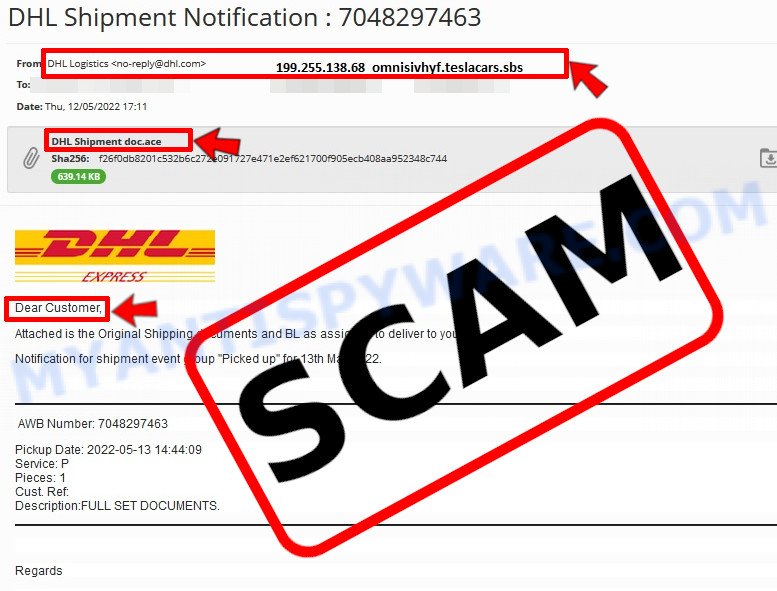
Here are some ways to recognize a phishing email
- Inconsistencies in Email Addresses. The most obvious way how to spot a scam email is finding inconsistencies in email addresses and domain names. If the email claims to be from a reputable company, like Amazon or PayPal, but the email is being sent from a public email domain, such as “gmail.com” it’s probably a scam.
- The domain name is misspelt. Look carefully for any subtle misspellings in the domain name. Like arnazon.com where the “m” has been replaced by “rn”, or paypa1.com, where the “l” has been replaced by “1”. These are common tricks of scammers.
- Generic greetings. If the email starts with a generic “Dear”, “Dear sir” or “Dear madam” that is a warning sign that it might not really be your shopping site or bank.
- Suspicious links. If you have the slightest suspicion an email may be a scam, do not click on the links you see. Instead, hover over the link, but don’t click it. This will pop up a small box that contains the actual URL. This works on image links as well as text links.
- Unexpected attachments. Email attachments should always be verified before clicking. Any attachments should be scanned for viruses – especially if they have an unfamiliar extension or one commonly associated with malware (.zip, .exe, .scr, etc.).
- The email creates a sense of urgency. Creating a false sense of urgency is a common trick of phishing emails. Be suspicious of emails that claim you must call, open an attachment or click a link immediately.
Report Scam Email
If you receive a scam email that is similar but not the same as the example above, make sure you remove any personal info in this message, then post it as comment on this article. This helps us to warn users about current scams, monitor trends and disrupt scams where possible.
